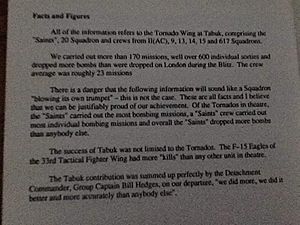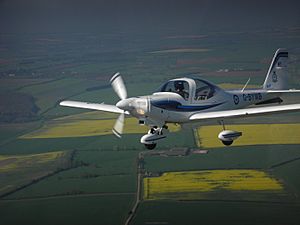No. 16 Squadron RAF facts for kids
Quick facts for kids No. 16 Squadron Royal Air Force |
|
|---|---|
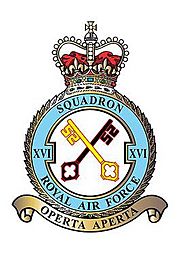
Squadron badge
|
|
| Active | Royal Flying Corps (RFC): 10 February 1915 – 1 April 1918 Royal Air Force (RAF): 1 April 1918 – 31 December 1919 1 April 1924 – 1 June 1957 1 March 1958 – 6 June 1972 8 January 1973 – 29 February 1984 1 March 1984 – 11 September 1991 1 November 1991 – 11 March 2005 1 October 2008 – present |
| Country | |
| Allegiance | King Charles III |
| Branch | |
| Type | Flying squadron |
| Role | Elementary flying training |
| Part of | No. 3 Flying Training School RAF |
| Home station | RAF Wittering |
| Nickname(s) | 'The Saints' |
| Motto(s) | Operta aperta (Latin for 'Hidden things are revealed') |
| Battle honours | * Honours marked with an asterisk may be emblazoned on the Squadron Standard |
| Insignia | |
| Squadron badge heraldry | Two keys in saltire. The badge symbolises army co-operation duties. The keys indicate the unlocking of the enemy's secrets; the gold key by day, the black key by night. Approved by King Edward VIII in November 1936. |
| Squadron roundel | |
| Aircraft flown | |
| Trainer | Grob Tutor T1 |
No. 16 Squadron Royal Air Force, also known as 'the Saints', is a special flying group within the Royal Air Force (RAF). They currently teach new pilots how to fly using the Grob Tutor T1 aircraft. Their home base is RAF Wittering in Cambridgeshire, England.
The squadron first started on 10 February 1915, as part of the Royal Flying Corps (RFC) in France. Their job was to fly patrols and gather information about the enemy during the First World War. After the war ended, the squadron was temporarily closed in 1919.
It reopened on 1 April 1924, as part of the new Royal Air Force. They continued to focus on reconnaissance, which means scouting and gathering information, throughout the Second World War. After this war, the squadron was closed and reopened a few times, changing its role to a bomber squadron.
From 1984, they flew the Tornado GR1 and took part in the Gulf War in 1990. The squadron closed again in 1991 but reformed later that year to train pilots for the Jaguar aircraft. When the Jaguar planes were retired, the squadron closed once more in 2005. No. 16 Squadron reformed again on 1 October 2008, taking on its current role of teaching basic flying skills.
Contents
Squadron History: A Look Back
Starting Out in World War I
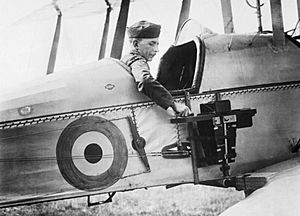
No. 16 Squadron was formed in France on 10 February 1915, combining parts of other squadrons. They immediately joined the fighting in the First World War. For a while, they were based near the Beaupré-sur-la-Lys Abbey in La Gorgue.
Throughout the war, the 'Saints' flew different types of aircraft like the Bleriot XI and Royal Aircraft Factory B.E.2c. Their main jobs were to patrol and gather information about enemy positions. The squadron was closed down on New Year's Eve in 1919.
The squadron reformed in England on 1 April 1924, to help the army by scouting from the air. They first used the Bristol F.2 Fighter, then the Armstrong Whitworth Atlas in 1931, and later the Hawker Audax in 1933.
World War II Missions

In May 1938, the squadron started using the Westland Lysander aircraft and continued its scouting role in France from April 1940. In May 1940, they returned to England. Their new task was to patrol the seas, looking for both downed aircrew and enemy ships.
From April 1942, 16 Squadron was given Mustang I planes. They used these for fighter sweeps and scouting missions over France. In September 1943, the Spitfire Mk.V took over this role. On 2 June 1943, the squadron became a high-altitude photo reconnaissance unit, taking pictures from the sky. These photos were very important for planning the Allied landings on D-Day.
Cold War Era: 1946–1991
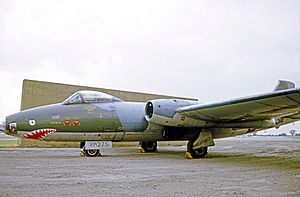
No. 16 Squadron was closed on 1 April 1946, but reformed on the same day. They flew Hawker Tempest Mk.V planes, later changing to the Mk.II. On 7 December 1948, the squadron received its first jet engined aircraft, the de Havilland Vampire FB.5. This was later replaced by the de Havilland Venom FB.1 in November 1954, until the squadron closed again on 1 June 1957.

The squadron reformed in West Germany on 1 March 1958. During the Cold War, No. 16 Squadron was always ready to respond to threats from the Soviet Union. They were equipped with Canberra B(I).8 planes, which carried special weapons for defense.
On 16 October 1972, the Canberra planes were replaced by the Buccaneer S.2B. The squadron's twelve Buccaneers carried various conventional weapons and also special deterrent weapons. The Buccaneer planes were very successful in bombing exercises, winning the Salmond Trophy in 1978 and 1979.
In 1983-1984, the squadron grew by taking on some planes and people from No. 15 Squadron. No. 16 Squadron then switched to the Panavia Tornado GR1 in late 1984. Even with the new aircraft, their role remained the same: to counter any threat in Europe with both regular and special deterrent weapons.
Before Operation GRANBY (the first Gulf War) in 1990, the squadron moved to Tabuk airbase. No. 16 was the first squadron to arrive, joined by No. 20 Squadron and crews from other Tornado GR1 squadrons. This 'Tabuk Force' used special bombs on low-level missions against Iraqi airfields and other targets. Some of the squadron's planes later used advanced targeting systems for accurate bombing from medium height.
After the fighting, the squadron closed down on 11 September 1991.
SEPECAT Jaguar Era: 1991–2005
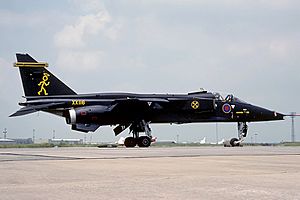
On 1 November 1991, the squadron reformed as No. 16(Reserve) Squadron. Its new job was to train new pilots for the SEPECAT Jaguar aircraft. Even though it was a reserve squadron, its planes were still equipped with conventional and special deterrent weapons for use in a major European conflict.
Although it was a training squadron, its pilots still took part in Operation Deny Flight and Operation Northern Watch. The squadron moved to RAF Coltishall in Norfolk on 21 July 2000, bringing all of the RAF's Jaguar planes to one base.
In December 2003, the Ministry of Defence announced that RAF Coltishall would close in 2007, and the Jaguar planes would be retired early. This led to No. 16 Squadron closing down on 11 March 2005, as the Jaguar planes were leaving service. The squadron's special flag was placed in Notre-Dame Cathedral in Saint-Omer, France, on 20 March 2005.
Teaching New Pilots: 2008–Present
On 1 October 2008, the squadron reformed at RAF Cranwell in Lincolnshire. They now operate the Grob Tutor T1 and teach new Royal Air Force pilots basic flying skills. This unit was previously known as 1 Squadron, 1 EFTS.
No. 16(R) Squadron trains new RAF pilots, along with some pilots from other countries. Their goal is to prepare pilots for more advanced flying courses, helping them earn their pilot 'wings' before they join a front-line squadron. In early 2008, Prince William began his flying career at No. 16 Squadron's location, flying his first solo flight in a Tutor plane. His father, King Charles III, also learned to fly at RAF Cranwell in 1971.
In 2015, No. 16(R) Squadron moved to RAF Wittering in Cambridgeshire. This brought flying back to the base for the first time since 2010.
Aircraft Flown by the Saints
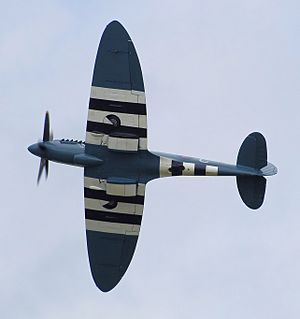
Over the years, No. 16 Squadron has flown many different types of aircraft. Here are some of the most important ones:
- Early Years (World War I): Royal Aircraft Factory R.E.5, Vickers FB5, Bleriot XI, Martinsyde S.1, Voisin III, Royal Aircraft Factory BE.2, Maurice Farman S.11, Royal Aircraft Factory R.E.8.
- Between the Wars: Bristol F.2 Fighter, Armstrong Whitworth Atlas, Hawker Audax.
- World War II: Westland Lysander, Mustang, Spitfire Mk.XI.
- Cold War Era: Tempest V and Tempest II, Vampire FB.5, Venom FB.1, Canberra B(I).8, Buccaneer S.2B, Tornado GR1.
- Post-Cold War: Jaguar GR1, GR3, T2, & T4.
- Current (Training): Tutor T1.
Where the Squadron Has Been Based
No. 16 Squadron has been based at many different airfields throughout its history. Here are some of the key locations:
- France (World War I): Saint-Omer, La Gorgue, Choques, Merville, Bruay, Camblain-l'Abbe, La Brayelle, Auchy.
- United Kingdom (Between Wars & WWII): Fowlmere, Old Sarum, Hawkinge, Lympne, Redhill, Cambridge, Okehampton, Western Zoyland, Thruxton, Andover, Ford, Middle Wallop, Hartford Bridge, Northolt.
- Germany (Post-WWII & Cold War): Celle, Fassberg, Gütersloh, Laarbruch.
- United Kingdom (Post-Cold War & Present): Lossiemouth, Coltishall, Cranwell, and currently Wittering.
Images for kids
See also
- List of Royal Air Force aircraft squadrons


